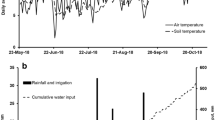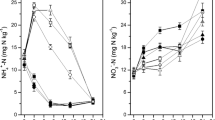Abstract
Yak (Bos grunniens) and Tibetan sheep urine deposited onto the alpine grasslands of the Qinghai-Tibetan Plateau is an important pathway for nutrient return, and it is closely related to soil fertility and alpine grassland productivity. However, hitherto, few studies have reported the effects of yak and Tibetan sheep urine deposition on soil carbon (C) and nitrogen (N) concentrations and the possible functional mechanisms under field conditions in alpine grasslands. To explore the status of soil C and N responding to the immediate N addition from livestock urine, we conducted a 28-d field experiment with three treatments, which include the application of yak urine (YU) and Tibetan sheep urine (TSU) application, and the control (CK, no application of urine). The results showed that YU treatment increased the soil moisture content and pH at 0–10 cm across the 28-day experimental period. Urine application resulted in the fluctuation of soil organic C (SOC) and increased topsoil SOC concentration during the middle and later periods of the experiment. Application of YU evidently increased the soil total N (TN) concentration in the 0–10 cm layer, while it did not affect the SOC concentrations in the 10–20 and 20–30 cm layers. Compared with the control, YU treatment significantly (P<0.05) increased the 0–10 and 10–20 cm soil ammonium-N (NH4+−N) concentration throughout the 28 days, while the TSU treatment significantly (P<0.05) increased the 0–10 and 10–20 cm soil nitrate-N (NO3−−N) concentration. Urine N input changed soil physicochemical properties, nitrification, denitrification, and N leaching processes, and therefore affected the availability of N accumulation and consumption in soil. Under these conditions, the trade-off between soil NH4+−N and NO3−− N under the influence of yak and Tibetan sheep urine application would change the form and concentration of available N, thereby altering the plant N uptake and utilization strategy of alpine grassland. The conclusions of this study could provide theoretical references for exploring the change characteristics of soil nutrient under the deposition of urine and optimizing the management strategies of livestock urine in the alpine grassland ecosystem.
Similar content being viewed by others
References
Aarons SR, O’Connor CR, Hosseini HM, et al. (2009) Dung pads increase pasture production, soil nutrients and microbial biomass carbon in grazed dairy systems. Nutr Cycl Agroecosys 84(1): 81–92. https://doi.org/10.1007/s10705-008-9228-5
Allen AG, Jarvis SC, Headon DM (1996) Nitrous oxide emissions from soils due to inputs of nitrogen from excreta return by livestock on grazed grassland in the UK. Soil Biol Biochem 28(4–5): 597–607. https://doi.org/10.1016/0038-0717(95)00186-7
Ambus P, Petersen SO, Soussana JF (2007) Short-term carbon and nitrogen cycling in urine patches assessed by combined carbon-13 and nitrogen-15 labelling. Agr Ecosyst Environ 121(1–2): 84–92. https://doi.org/10.1016/j.agee.2006.12.007
Bertram JE, Clough TJ, Sherlock RR, et al. (2009) Hippuric acid and benzoic acid inhibition of urine derived N2O emissions from soil. Glob Change Biol 15(8): 2067–2077. https://doi.org/10.1111/j.1365-2486.2008.01779.x
Botter G, Settin T, Marani M, et al. (2006) A stochastic model of nitrate transport and cycling at basin scale. Water Resour Res 42(4): 04415. https://doi.org/10.1029/2005WR004599
Bouwman L, Goldewijk KK, Van Der Hoek KW, et al. (2013) Exploring global changes in nitrogen and phosphorus cycles in agriculture induced by livestock production over the 1900–2050 period. Proc Nat Acad Sci 110(52): 20882–20887. https://doi.org/10.1073/pnas.1012878108
Byrnes RC, Nunez J, Arenas L, et al. (2017) Biological nitrification inhibition by Brachiaria grasses mitigates soil nitrous oxide emissions from bovine urine patches. Soil Biol Biochem 107: 156–163. https://doi.org/10.1016/j.soilbio.2016.12.029
Cai YJ, Akiyama H (2016) Nitrogen loss factors of nitrogen trace gas emissions and leaching from excreta patches in grassland ecosystems: A summary of available data. Sci Total Environ 572: 185–195. https://doi.org/10.1016/j.scitotenv.2016.07.222
Cai YJ, Du ZY, Yan Y, et al. (2017) Greater stimulation of greenhouse gas emissions by stored yak urine than urea in an alpine steppe soil from the Qinghai-Tibetan Plateau: A laboratory study. Grassl Sci 63(3): 196–207. https://doi.org/10.1111/grs.12164
Clough TJ, Kelliher FM (2005) Dairy Farm Effluent Effects on Urine Patch Nitrous Oxide and Carbon Dioxide Emissions. J Environ Qual 34(3): 979–986. https://doi.org/10.2134/jeq2004.0360
de Klein CAM, Vanlogtestijn RSP (1994) Denitrification and N2O emission from urine-affected grassland soil. Plant Soil 163(2): 235–241. https://doi.org/10.1007/BF00007973
Di HJ, Cameron KC (2002) Nitrate leaching in temperate agroecosystems: sources, factors and mitigating strategies. Nutr Cycl Agroecosys 64(3): 237–256. https://doi.org/10.1023/a:1021471531188
Di HJ, Cameron KC, Podolyan A, et al. (2014) Effect of soil moisture status and a nitrification inhibitor, dicyandiamide, on ammonia oxidizer and denitrifier growth and nitrous oxide emissions in a grassland soil. Soil Biol Biochem 73: 59–68. https://doi.org/10.1016/j.soilbio.2014.02.011
Dixon ER, Laughlin RJ, Watson CJ, et al. (2010) Evidence for the production of NO and N2O in two contrasting subsoils following the addition of synthetic cattle urine. Rapid Commun Mass Sp 24(5): 519–528. https://doi.org/10.1002/rcm.4348
Du ZY, Cai YJ, Yan Y, et al. (2017) Embedded rock fragments affect alpine steppe plant growth, soil carbon and nitrogen in the northern Tibetan Plateau. Plant Soil 420(1): 79–92. https://doi.org/10.1007/s11104-017-3376-9
Du ZY, Wang XD, Liu XP, et al. (2016) Effects of rock fragments on yak dung greenhouse gas emissions on the Qinghai-Tibetan Plateau. J Mt Sci 13(11): 2006–2014. https://doi.org/10.1007/s11629-015-3798-x
Du ZY, Wang XD, Xiang J, et al. (2021) Yak dung pat fragmentation affects its carbon and nitrogen leaching in Northern Tibet, China. Agr Ecosyst Environ 310: 107301. https://doi.org/10.1016/j.agee.2021.107301
Fu G, Shen ZX, Zhang XZ, et al. (2012) Response of microbial biomass to grazing in an alpine meadow along an elevation gradient on the Tibetan Plateau. Eur J Soil Biol 52:27–29. https://doi.org/10.1016/j.ejsobi.2012.05.004
Fu G, Shen ZX (2016) Response of alpine plants to nitrogen addition on the Tibetan Plateau: a meta-analysis. J Plant Growth Regul 35(4): 974–979. https://doi.org/10.1007/s00344-016-9595-0
Fu G, Shen ZX (2017) Response of alpine soils to nitrogen addition on the Tibetan Plateau: a meta-analysis. Appl Soil Ecol 114: 99–104. https://doi.org/10.1016/j.apsoil.2017.03.008
Gong ZT (1999) Chinese Soil Taxonomy: Theories, Methods and Applications. Science Press, Beijing (in Chinese)
Haynes RJ, Williams PH (1993) Nutrient cycling and soil fertility in the grazed pasture ecosystem. In: LS Donald (ed) Advances in Agronomy. Academic Press.
Hong JT, Ma XX, Wang XD (2016) Leaf meristems: an easily ignored component of the response to human disturbance in alpine grasslands. Ecol Evol 6: 2325–2332. https://doi.org/10.1002/ece3.2059
Hong JT, Ma XX, Zhang XK, et al. (2017) Nitrogen uptake pattern of herbaceous plants: coping strategies in altered neighbor species. Biol Fert Soils 53: 729–735. https://doi.org/10.1007/s00374-017-1230-0
IUSS Working Group WRB (2014) World Reference Base for Soil Resources 2014. International soil classification system for naming soil and creating legends for soil maps. Food and Agriculture Organization of the United Nations. Rome: pp.154
Lambie SM, Schipper LA, Balks MR, et al. (2013) Priming of soil decomposition leads to losses of carbon in soil treated with cow urine. Soil Res 51: 513–520. https://doi.org/10.1071/SR13148
Lantinga E, Keuning J, Groenwold J, et al. (1987) Distribution of excreted nitrogen by grazing cattle and its effects on sward quality, herbage production and utilization. Animal Manure on Grassland and Fodder Crops Fertilizer or Waste? Springer.
Lin XW, Wang SP, Ma XZ, et al. (2009) Fluxes of CO2, CH4, and N2O in an alpine meadow affected by yak excreta on the Qinghai-Tibetan plateau during summer grazing periods. Soil Biol Biochem 41(4): 718–725. https://doi.org/10.1016/j.soilbio.2009.01.007
Lovell RD, Jarvis SC (1996) Effect of cattle dung on soil microbial biomass C and N in a permanent pasture soil. Soil Biol Biochem 28(3): 291–299. https://doi.org/10.1016/0038-0717(95)00140-9
Lu XY, Yan Y, Fan JH, et al. (2012) Gross nitrification and denitrification in alpine grassland ecosystems on the Tibetan Plateau. Arct Antarct Alp Res 44(2): 188–196. https://doi.org/10.1657/1938-4246-44.2.188
Ma XZ, Wang SP, Wang YF, et al. (2006) Short‐term effects of sheep excrement on carbon dioxide, nitrous oxide and methane fluxes in typical grassland of Inner Mongolia. New Zeal J Agr Res 49(3): 285–297. https://doi.org/10.1080/00288233.2006.9513719
Miller DJ (1990) Grasslands of the Tibetan Plateau. Rangelands Archives 12(3): 159–163.
Monaghan RM, Cameron KC, McLay CDA (1989) Leaching losses of nitrogen from sheep urine patches. New Zeal J Agr Res 32(2): 237–244. https://doi.org/10.1080/00288233.1989.10423459
Petersen SO, Sommer SG, Aaes O, et al. (1998) Ammonia losses from urine and dung of grazing cattle: Effect of N intake. Atmos Environ 32(3): 295–300. https://doi.org/10.1016/s1352-2310(97)00043-5
Sharpley AN (1991) Effect of soil pH on cation and anion solubility. Commun Soil Sci Plan 22(9–10): 827–841. https://doi.org/10.1080/00103629109368457
Singh J, Saggar S, Giltrap D, et al. (2008) Decomposition of dicyandiamide (DCD) in three contrasting soils and its effect on nitrous oxide emission, soil respiratory activity, and microbial biomass — An incubation study. Aust J Soil Res 46(7): 517–525. https://doi.org/10.1071/SR07204
Somda ZC, Powell JM, Bationo A (1997) Soil pH and nitrogen changes following cattle and sheep urine deposition. Commun Soil Sci Plan 28(15–16): 1253–1268. https://doi.org/10.1080/00103629709369872
Sun W, Li SW, Wang JH, et al. (2021) Effects of grazing on plant species and phylogenetic diversity in alpine grasslands, Northern Tibet. Ecol Eng 170: 106331. https://doi.org/10.1016/j.ecoleng.2021.106331
van Groenigen JW, Palermo V, Kool DM, et al. (2006) Inhibition of denitrification and N2O emission by urinederived benzoic and hippuric acid. Soil Biol Biochem 38(8): 2499–2502. https://doi.org/10.1016/j.soilbio.2006.02.023
van Groenigen JW, Velthof GL, van der Bolt FJE, et al. (2005) Seasonal variation in N2O emissions from urine patches: Effects of urine concentration, soil compaction and dung. Plant Soil 273(1–2): 15–27. https://doi.org/10.1007/s11104-004-6261-2
Whitehead DC (2000) Nutrient elements in grassland: soilplant-animal relationships. CABI Publishing.
Yoshitake S, Soutome H, Koizumi H (2014) Deposition and decomposition of cattle dung and its impact on soil properties and plant growth in a cool-temperate pasture. Ecol Res 29(4): 673–684. https://doi.org/10.1007/s11284-014-1153-2
Yue GY, Zhao L, Zhao YH, et al. (2010) Research Advances of Grassland Ecosystem CO2 Flux on Qinghai-Tibetan Plateau. J Glaciol Geocryol 32: 166–174. https://doi.org/10.3724/SP.J.1077.2010.01263
Zhang HR, Fu G (2021) Responses of plant, soil bacterial and fungal communities to grazing vary with pasture seasons and grassland types, northern Tibet. Land Degrad Dev 32(4): 1821–1832. https://doi.org/10.1002/ldr.3835
Acknowledgements
This study was supported by the National Natural Science Foundation of China (Grant NO. 41807109), the Second Tibetan Plateau Scientific Expedition and Research Program (Grant NO. 2019QZKK0404), the doctoral research launch fund project and National general cultivation project of China West Normal University (Grant NO. 17E042, 18B016).
Author information
Authors and Affiliations
Corresponding author
Rights and permissions
About this article
Cite this article
Du, Zy., Wang, Xd. & Cai, Yj. Short-term effects of yak and Tibetan sheep urine deposition on soil carbon and nitrogen concentrations in an alpine steppe of the northern Tibetan Plateau, China. J. Mt. Sci. 19, 1156–1167 (2022). https://doi.org/10.1007/s11629-021-7026-6
Received:
Revised:
Accepted:
Published:
Issue Date:
DOI: https://doi.org/10.1007/s11629-021-7026-6




